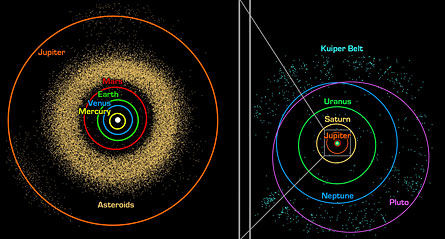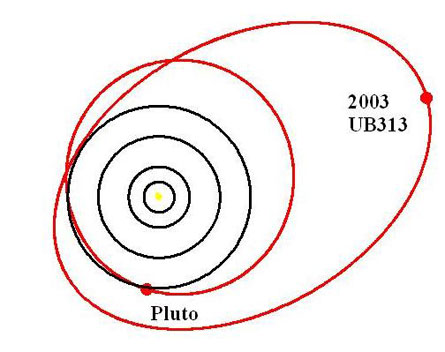Pluto, plutoid: What's in a name?
A rose by any other name would smell as sweet, wrote William Shakespeare. But what would astronomers order just about a planet aside any past name?
It's a question astronomers have been talking about since 2006. That's when an international system changed the classification of Pluto from major planet to "dwarf planet." That same organization has now come ahead with yet another term. It describes them A a new class of Pluto-like objects.
Objects in this new category would be called "plutoids." Accordant to the International Large Join (IAU), plutoids are dwarf planets that orb the sun beyond the orbit of Neptune.
This sets these plutoids apart from another star system dwarf planet called Ceres, It resides in the asteroid belt between Mars and Jupiter. Information technology's an important distinction, says Brian G. Marsden. He's an stargazer at the Harvard-Smithsonian Center for Astrophysics in Cambridge, Mass. Ceres is a rocky dwarf planet,. Pluto is shiny. Because the cardinal have different material traits, they should not represent grouped into the same category.
 |
| This graphic shows the Asteroid Belt and the Gerard Peter Kuiper Belt. The Asteroid Belt, the fuzzy ring of dots on the left, is where the nanus planet Ceres is located. The belt lies between the orbit of Mars and Jupiter, at the edge of what's called the inner solar system. The image on the right shows the Kuiper Belt, at the outer edge of the solar system. This bash is home to Pluto, Eris and probably other plutoids. |
| NASA |
The new class and appoint think over a growing body of evidence showing that Pluto shares its neighborhood with numerous other objects in the outer solar scheme that all sphere the sun. Planets, but then, travel alone in their orbits with no nearby neighbors demur their moons. The observation suggests that Hades isn't big sufficiency and heavy enough to have the gravity to "clear its orbit," removing nearby objects by either slinging them farther out into space or pull them toward its surface.
The power to limpid the orbit was unrivalled of the main criteria the IAU in use in 2006 to justify changing Pluto's status from planet to dwarf satellite. A planet should be large sufficiency that its gravity dominates everything other hot its orbit, IAU said. It's an mind based on astronomers' theories about how the star system originally formed.
Billions of old age ago, they say, the solar organisation was made up of many small objects spread in a magnetic disc around the sun. Some of those objects grew aside pulling other objects into them, much the fashio a snowball grows when you add more snow thereto. As these objects grew larger, their gravity attracted more pieces of material to them. Eventually, they swept clean the entire zone in a deep path around them. Put differently, they "cleared their area" of other material. Because numerous other objects orbit the sun artificial Pluto, approximately astronomers state IT doesn't have the size to clear its own orbit.
Aidoneus is still large enough for its own gravity to crush its mass into a spherical shape. And that sets it apart from other, smaller solar system of rules objects corresponding asteroids. So classifying IT as a gnome planet explains how IT interacts (or, actually, how it doesn't interact) with other objects in the solar system. The additional classification as a plutoid makes clear where in the solar system Pluto and different objects equal it reside.
Soh far, astronomers have named one past plutoid — the shadow major planet Eris, whose discovery in 2003 sparked the controversy all over whether it was correct to keep calling Aidoneus a major planet. Since then, astronomers have set up other plutoids, Marsden says.
"Now that we've gotten the go-in advance from the IAU, the third plutoid will make up named before long," he says.
Regardless of the terminology scientists use, Pluto and other objects like it will continue to teach us more about the structure of the solar system. Losing its assortment As a planet doesn't make Pluto whatsoever less deserving of study, says Neil deGrasse Tyson, director of the Hayden Planetarium at the Earth Museum of Natural History in New York.
"Pluto is calm Pluto," atomic number 2 says. "And I am quite sure it does not concern itself with what we choose to call it. And whatever we call it, it's no less interesting a cosmic objective than information technology was earlier all this began."


Post a Comment for "Pluto, plutoid: What's in a name?"